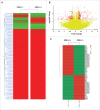Identification of SSEA-1 expressing enhanced reprogramming (SEER) cells in porcine embryonic fibroblasts
- PMID: 28426281
- PMCID: PMC5499827
- DOI: 10.1080/15384101.2017.1315490
Identification of SSEA-1 expressing enhanced reprogramming (SEER) cells in porcine embryonic fibroblasts
Abstract
Previous research has shown that a subpopulation of cells within cultured human dermal fibroblasts, termed multilineage-differentiating stress enduring (Muse) cells, are preferentially reprogrammed into induced pluripotent stem cells. However, controversy exists over whether these cells are the only cells capable of being reprogrammed from a heterogeneous population of fibroblasts. Similarly, there is little research to suggest such cells may exist in embryonic tissues or other species. To address if such a cell population exists in pigs, we investigated porcine embryonic fibroblast populations (pEFs) and identified heterogeneous expression of several key cell surface markers. Strikingly, we discovered a small population of stage-specific embryonic antigen 1 positive cells (SSEA-1+) in Danish Landrace and Göttingen minipig pEFs, which were absent in the Yucatan pEFs. Furthermore, reprogramming of SSEA-1+ sorted pEFs led to higher reprogramming efficiency. Subsequent transcriptome profiling of the SSEA-1+ vs. the SSEA-1neg cell fraction revealed highly comparable gene signatures. However several genes that were found to be upregulated in the SSEA-1+ cells were similarly expressed in mesenchymal stem cells (MSCs). We therefore termed these cells SSEA-1 Expressing Enhanced Reprogramming (SEER) cells. Interestingly, SEER cells were more effective at differentiating into osteocytes and chondrocytes in vitro. We conclude that SEER cells are more amenable for reprogramming and that the expression of mesenchymal stem cell genes is advantageous in the reprogramming process. This data provides evidence supporting the elite theory and helps to delineate which cell types and specific genes are important for reprogramming in the pig.
Keywords: SSEA-1; fibroblast; induced pluripotent stem cell; porcine; reprogramming.
Figures







Similar articles
-
Muse Cells, a New Type of Pluripotent Stem Cell Derived from Human Fibroblasts.Cell Reprogram. 2016 Apr;18(2):67-77. doi: 10.1089/cell.2015.0085. Cell Reprogram. 2016. PMID: 27055628
-
Diversity of dermal fibroblasts as major determinant of variability in cell reprogramming.J Cell Mol Med. 2019 Jun;23(6):4256-4268. doi: 10.1111/jcmm.14316. Epub 2019 Apr 13. J Cell Mol Med. 2019. PMID: 30980516 Free PMC article.
-
Derivation of induced pluripotent stem cells from pig somatic cells.Proc Natl Acad Sci U S A. 2009 Jul 7;106(27):10993-8. doi: 10.1073/pnas.0905284106. Epub 2009 Jun 18. Proc Natl Acad Sci U S A. 2009. PMID: 19541600 Free PMC article.
-
The Muse Cell Discovery, Thanks to Wine and Science.Adv Exp Med Biol. 2018;1103:1-11. doi: 10.1007/978-4-431-56847-6_1. Adv Exp Med Biol. 2018. PMID: 30484221 Review.
-
Regenerative potential of pluripotent nontumorgenetic stem cells: Multilineage differentiating stress enduring cells (Muse cells).Regen Ther. 2020 Jul 27;15:92-96. doi: 10.1016/j.reth.2020.04.011. eCollection 2020 Dec. Regen Ther. 2020. PMID: 33426206 Free PMC article. Review.
Cited by
-
Study of the protective effect on damaged intestinal epithelial cells of rat multilineage-differentiating stress-enduring (Muse) cells.Cell Biol Int. 2020 Feb;44(2):549-559. doi: 10.1002/cbin.11255. Epub 2019 Nov 6. Cell Biol Int. 2020. PMID: 31642560 Free PMC article.
-
Oocytes, embryos and pluripotent stem cells from a biomedical perspective.Anim Reprod. 2019 Oct 23;16(3):508-523. doi: 10.21451/1984-3143-AR2019-0054. Anim Reprod. 2019. PMID: 32435294 Free PMC article.
References
-
- Ezashi T, Telugu BP, Roberts RM. Induced pluripotent stem cells from pigs and other ungulate species: An alternative to embryonic stem cells?. Reprod Domest Anim 2012; 47 Suppl 4:92-7; PMID: 22827356; https://doi.org/ 10.1111/j.1439-0531.2012.02061.x - DOI - PubMed
-
- Wu J, Platero-Luengo A, Sakurai M, Sugawara A, Gil MA, Yamauchi T, Suzuki K, Bogliotti YS, Cuello C, Morales Valencia M, et al.. Interspecies chimerism with mammalian pluripotent stem cells. Cell 2017; 168:473-486.e15; PMID: 28129541; https://doi.org/ 10.1016/j.cell.2016.12.036 - DOI - PMC - PubMed
-
- Dehoux J-P, Gianello P. The importance of large animal models in transplantation. Front Biosci 2007; 12:4864-80; PMID: 17569616; https://doi.org/ 10.2741/2434 - DOI - PubMed
-
- Samavarchi-Tehrani P, Golipour A, David L, Sung H-K, Beyer TA, Datti A, Woltjen K, Nagy A, Wrana JL. Functional genomics reveals a BMP-driven mesenchymal-to-epithelial transition in the initiation of somatic cell reprogramming. Cell Stem Cell 2010; 7:64-77; PMID: 20621051; https://doi.org/ 10.1016/j.stem.2010.04.015 - DOI - PubMed
-
- Golipour A, David L, Liu Y, Jayakumaran G, Hirsch CL, Trcka D, Wrana JL. A late transition in somatic cell reprogramming requires regulators distinct from the pluripotency network. Cell Stem Cell 2012; 11:769-82; PMID: 23217423; https://doi.org/ 10.1016/j.stem.2012.11.008 - DOI - PubMed
MeSH terms
Substances
LinkOut - more resources
Full Text Sources
Other Literature Sources
Research Materials
